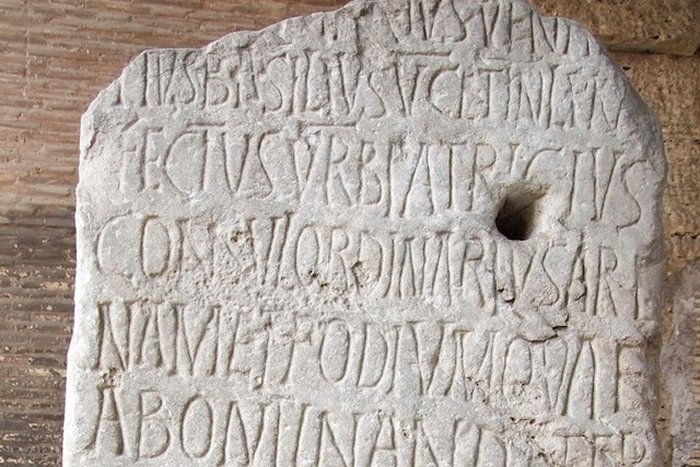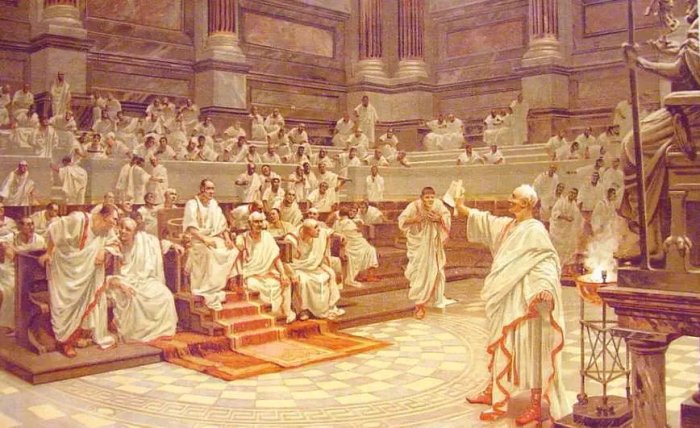Acta Diurna: World’s First Newspaper Appeared In 131 B.C
Conny Waters - AncientPages.com - The history of newspapers goes far back in time. The first proto-newspaper appeared as early as 131 B.C. It was an ancient Roman daily gazette called Acta Diurna (Daily Acts sometimes translated as Daily Public Records). Acta Diurna informed citizens of political and social happenings in ancient Rome.
News of events such as military victories, gladiatorial bouts and other games, births and deaths and even human-interest stories were inscribed on metal or stone and posted in areas with heavy foot traffic, such as the Roman Forum where free citizens met to discuss ideas, philosophy and politics.
Acta Diurna was the first "newspaper".
After a couple of days the notes were taken down and archived. Unfortunately, no intact copy of the Acta Diurna has survived to the present day.
See also:
Palermo Stone: Oldest History Book Of Ancient Egypt
Codes Of Ur Nammu: World’s Oldest Known Law Code
World’s Oldest Dictionaries Are 4,500-Year-Old Cuneiform Tablets Discovered In Ebla
More Fascinating Ancient History Facts
Sometimes scribes made copies of the Acta and sent them to provincial governors for information. Later emperors used them to announce royal or senatorial decrees and events of the court.
Caesar in the Senate. Credit: Pillole di storia
Tacitus, a senator and a historian of the Roman Empire and Suetonius, Roman historian of the Equestrian Order used these Acta as sources of information about the empire’s early emperors in their histories of Rome.
For many Romans the innovation of the year 59 B.C. must have been a blessing. In that year Caesar was consul, and devoted himself to the task of weakening the Senate. One of the privileges of that body had been a meeting in executive session. Only so much of their deliberations was made public as suited the senators. Caesar, however, arranged that reports of their proceedings should be made public. These reports were called the acta diurna, and constitute the original newspaper.
As Evan T. Sage explains in Advertising among the Romans, "at first they must have included only brief summaries of the meetings. Later, some changes occurred. There seems to have been something resembling the congressional leave to print. At any rate, sometimes speeches were transcribed, with even the interruptions noted.
The most famous example is the speech of the Emperor Claudius on admitting Gauls to the Senate, of which we have another version in Tacitus. With the fall of the Republic the sessions ceased to have so much importance, and the act took on more of the look of the society and local columns of our papers.
Thus we find recorded in the acta the visit to the Emperor of a certain C. Crispinius Hilarus with sixty-one descendants in the direct line; imperial decrees; the story of a faithful dog; various prodigies; divorces; benefactions; suicides; acclamations; construction of public buildings, etc. Doubtless, there might be included announcements of games, readings of poets, etc., and this would correspond to the intrusion of similar matter into the news columns of modern papers.
Written by Conny Waters – AncientPages.com Staff Writer
Copyright © AncientPages.com All rights reserved. This material may not be published, broadcast, rewritten or redistributed in whole or part without the express written permission of AncientPages.com
Expand for referencesSage, Evan T. "Advertising among the Romans." The Classical Weekly 9, no. 26 (1916): 202-08. doi:10.2307/4387300.
More From Ancient Pages
-
 Mysterious Hornet Spook Light In Missouri
Featured Stories | Jun 26, 2024
Mysterious Hornet Spook Light In Missouri
Featured Stories | Jun 26, 2024 -
 Indigenous Village Estimated To Be 11,000 Years Old – Discovered Near Sturgeon Lake
Archaeology | Feb 10, 2025
Indigenous Village Estimated To Be 11,000 Years Old – Discovered Near Sturgeon Lake
Archaeology | Feb 10, 2025 -
 Remains Of A Roman Ship Discovered In Serbia
Archaeology | Aug 7, 2023
Remains Of A Roman Ship Discovered In Serbia
Archaeology | Aug 7, 2023 -
 Andalusia Was First Inhabited By Neolithic People From The Southern Part Of The Iberian Peninsula 6,200 Years Ago
Archaeology | Feb 26, 2024
Andalusia Was First Inhabited By Neolithic People From The Southern Part Of The Iberian Peninsula 6,200 Years Ago
Archaeology | Feb 26, 2024 -
 Rare Bes Mugs Reveal Ancient Egyptians Drank Hallucinogenic Cocktails During Rituals
Archaeology | Nov 18, 2024
Rare Bes Mugs Reveal Ancient Egyptians Drank Hallucinogenic Cocktails During Rituals
Archaeology | Nov 18, 2024 -
 3,600-Year-Old Bronze Dagger Made By The Minoan Civilization Found On Ancient Shipwreck
Archaeology | Sep 13, 2024
3,600-Year-Old Bronze Dagger Made By The Minoan Civilization Found On Ancient Shipwreck
Archaeology | Sep 13, 2024 -
 Hasankeyf – 12,000-Year-Old Mesopotamian City Will Be Destroyed – Decision Sparks Outrage And Controversy
Archaeology | Aug 28, 2019
Hasankeyf – 12,000-Year-Old Mesopotamian City Will Be Destroyed – Decision Sparks Outrage And Controversy
Archaeology | Aug 28, 2019 -
 Fantastic Discovery At Hadrian’s Wall Reported By Archaeologists
Archaeology | Sep 10, 2022
Fantastic Discovery At Hadrian’s Wall Reported By Archaeologists
Archaeology | Sep 10, 2022 -
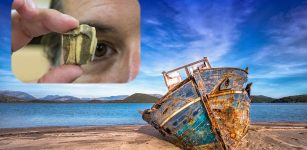 Oldest DNA From Domesticated American Horse Solves An Legendary Shipwreck Mystery
Archaeology | Jul 27, 2022
Oldest DNA From Domesticated American Horse Solves An Legendary Shipwreck Mystery
Archaeology | Jul 27, 2022 -
 Ancient Maya Reservoirs Contained Toxic Pollution – New Study
Archaeology | Jun 27, 2020
Ancient Maya Reservoirs Contained Toxic Pollution – New Study
Archaeology | Jun 27, 2020 -
 Puzzling Sakwala Chakraya Carving Could Be World’s Oldest Map Of The Universe – Mystery Of Sri Lanka’s Stargate
Featured Stories | May 15, 2021
Puzzling Sakwala Chakraya Carving Could Be World’s Oldest Map Of The Universe – Mystery Of Sri Lanka’s Stargate
Featured Stories | May 15, 2021 -
 Ancient Tools Used In Religious Rituals In Honor Of Goddess Hathor Discovered In Egypt
Archaeology | Sep 27, 2021
Ancient Tools Used In Religious Rituals In Honor Of Goddess Hathor Discovered In Egypt
Archaeology | Sep 27, 2021 -
 Viking Ragnar Lodbrok Wanted To Kill His Son Ivar The Boneless
Featured Stories | Jun 19, 2017
Viking Ragnar Lodbrok Wanted To Kill His Son Ivar The Boneless
Featured Stories | Jun 19, 2017 -
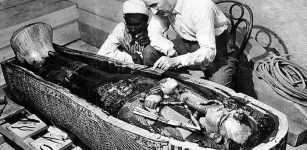 On This Day In History: King Tut’s Tomb Is Unsealed And Opened – On Feb 16, 1923
News | Feb 16, 2017
On This Day In History: King Tut’s Tomb Is Unsealed And Opened – On Feb 16, 1923
News | Feb 16, 2017 -
 Rare Preserved Written Account Of North America’s Ancient Lost Civilization Of Tall Beings From An Unknown Land
Featured Stories | Aug 25, 2024
Rare Preserved Written Account Of North America’s Ancient Lost Civilization Of Tall Beings From An Unknown Land
Featured Stories | Aug 25, 2024 -
 Malignant Serpent God Apophis: Symbol Of Chaos And Forces Of Darkness
Ancient Symbols | Oct 13, 2016
Malignant Serpent God Apophis: Symbol Of Chaos And Forces Of Darkness
Ancient Symbols | Oct 13, 2016 -
 Unexplained Phenomenon Around Yellowstone Puzzles Scientists
Featured Stories | Nov 12, 2018
Unexplained Phenomenon Around Yellowstone Puzzles Scientists
Featured Stories | Nov 12, 2018 -
 Roman Coin Hoards Found In The Conwy Valley Declared Treasure
Archaeology | Oct 20, 2023
Roman Coin Hoards Found In The Conwy Valley Declared Treasure
Archaeology | Oct 20, 2023 -
 Intriguing 3,400-Year-Old Multipurpose Pyramid Found In Kazakhstan
Archaeology | Nov 2, 2023
Intriguing 3,400-Year-Old Multipurpose Pyramid Found In Kazakhstan
Archaeology | Nov 2, 2023 -
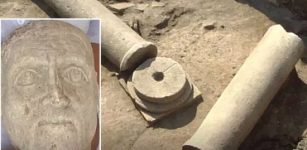 Third-Century Sculpture Of Roman Emperor Aurelian Unearthed In Bulgaria
Archaeology | Sep 5, 2018
Third-Century Sculpture Of Roman Emperor Aurelian Unearthed In Bulgaria
Archaeology | Sep 5, 2018

